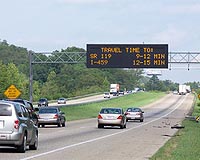 |
Redlands CA (SPX) Oct 01, 2009 The Eugene Police Department (EPD) in Oregon has transformed how it takes advantage of maps and related data throughout the agency, deploying powerful desktop and Web geographic information systems (GIS) to more effectively carry out law enforcement tasks. EPD links its records management data, computer-aided dispatch data, and information from other sources to an easily shared information resource. Commanders make long-term strategic decisions using high-level spatial analysis, frontline officers use mapped data for better decisions in the field, and a public Web site helps the agency keep its citizens abreast of crime rates in their neighborhoods. "We use it now for long-term planning and daily operations," says Stan Lenhart, crime analyst, Eugene Police Department. "It also really paid dividends for the Olympic trials. It won't make decisions for you. That's what employees get paid to do. But it helps us deliver more accurate information faster to all of our officers." EPD's GIS solution assists with data integration, management, analysis, and mapping needs. The agency deploys CrimeView, a desktop solution from The Omega Group, an ESRI business partner based in San Diego, California. The solution supplies an advanced interface to computer-aided dispatch and records management system databases. Crime analysts perform sophisticated spatial computing operations that accurately show crime patterns over time and help predict future illegal activity. Employees can query data by attribute, geographic boundary, or proximity to a location or specified landmark. They can build density maps-such as clustering residential burglaries-to see where officers can best be allocated for crime response. Hot spot maps help display areas of high, moderate, and low crime rates. For instance, data from the records management system can be extracted and mapped to show areas with a high number of reported assaults for a four-week time period. Maps are also generated showing repeat calls for service. Officers can use a map interface to click on the address icon and view a data table showing the number of recent calls and related data, such as incident type, responding officer, resulting action, and date and time of the call. They gain a better understanding of the conditions they are entering based on previously recorded data. Lenhart also uses GIS tools to develop crime reports from monthly computer statistics presented to all department supervisors and managers at quarterly strategy meetings. Spatial trend maps compare changes in crime patterns via a map view for specified times periods, for instance, robberies between two successive years. This gives commanders a macro-level understanding of crime trends. They can then better determine exactly where and how to respond to existing conditions on the ground. A property crimes initiative has been adopted that will expand the use of GIS even further. The comprehensive, interagency community strategy, led by the EPD, will help staff better understand property crime using locational data. GIS maps will be used in daily operations as EPD staff work with other organizations to address a myriad of crimes such as burglary, robbery, arson, and felony theft. They can then collaborate to better allocate people and resources to effectively address victimization prevention, crime interdiction, theft issues, and more. Share This Article With Planet Earth
Related Links ESRI City of Eugene Crime Statistics GPS Applications, Technology and Suppliers
 Waze turning road warriors into map builders
Waze turning road warriors into map buildersSan Diego, California (AFP) Sept 24, 2009 Technology startup Waze is tapping into the collective knowledge of road warriors in order to make life more pleasant for drivers while creating reliable street maps. A free Waze: Way to Go service that proved its worth in Israel is making its US debut, inviting motorists to use smart phones to keep one another in the know about speed traps, short cuts, hazards, accidents and more. ... read more |
|
| The content herein, unless otherwise known to be public domain, are Copyright 1995-2009 - SpaceDaily. AFP and UPI Wire Stories are copyright Agence France-Presse and United Press International. ESA Portal Reports are copyright European Space Agency. All NASA sourced material is public domain. Additional copyrights may apply in whole or part to other bona fide parties. Advertising does not imply endorsement,agreement or approval of any opinions, statements or information provided by SpaceDaily on any Web page published or hosted by SpaceDaily. Privacy Statement |